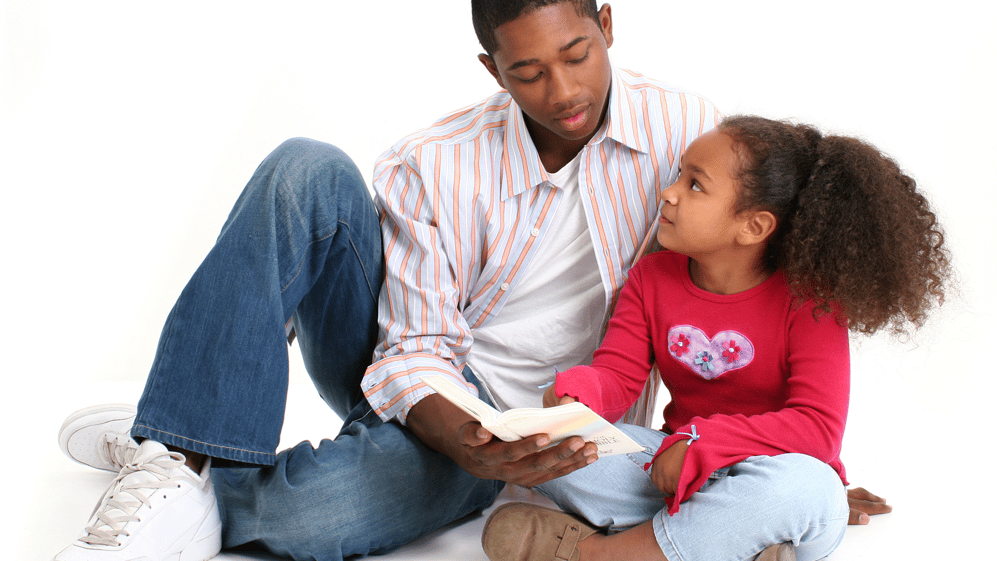Children’s Bibles serve a useful purpose in our homes. From the time our firstborn was four months old (in other words, when we emerged from our sleep-deprived fog enough to realize it was possible to start an intentional bedtime routine), we have read Bible stories with our children before bedtime. We started with an illustrated beginner’s Bible, moving up to Bibles with more of the stories and more details as our kids get older. Now we go back and forth between the Bible and storybook Bibles (as we have a wider range of ages in our family).
Why Children’s Story Bibles Are Helpful
I’ve found that children’s Bibles are helpful for two main reasons:
- First, little kids have an easier time paying attention when there are pictures and the language is simple.
- Second, story Bibles help children learn the scope and sequence of the biblical narrative so that when they start reading the Bible, they know where they are in the story of salvation and understand the context of the passage they are reading.
The goals of a children’s Bible are to teach kids what God’s Word says, to help them form the habit of reading the Bible regularly, and to provide them with basic biblical literacy so that when they read the Bible, they are equipped to understand it. There are more children’s Bibles on the market than can be counted, yet sadly, they do not all teach kids God’s Word faithfully.
The Effects of Choosing Children’s Bible Resources Wisely
It may seem counter-intuitive, but I have noticed that children’s devotional resources are one of the easiest places for false teaching to enter our home. We may assume that since a children’s book is simple, it cannot be problematic. But often, the opposite is true. When we simplify a story or a concept, we choose what elements of that story we think are the most significant. The Bible is divinely inspired and infallible, but when an author puts the truths of Scripture into his or her own words, they are not infallible and cannot avoid their own theological bias.
It is my mission to teach my kids the faith clearly and faithfully because I believe it is true. This does not mean we only read books written by my church’s publisher, but it does mean that I want to be discerning and teach my children how to be discerning as we read and think about what we are reading. A children’s Bible, however, is a book that I do not want to have extra room for theological differences. I want my children’s first experiences with the accounts in God’s Word to be trustworthy and to reflect scriptural inerrancy.
Five Things to Look for When Selecting a Children’s Bible
Here are the things I look for when evaluating a children’s Bible for the first time:
- I open to the creation story and check that the “days” have not been edited out. Many modern children’s Bibles leave out the “And there was evening and there was morning, the first day” line (Genesis 1:3). They often only list the things God created. This is a serious omission and likely indicates that the author does not believe God truly created the world in six literal days. Such an omission suggests the author does not hold to scriptural inerrancy, throwing the rest of his or her work into doubt.
- I turn to the Last Supper story. Do Jesus’ words in Scripture appear unedited as “This is My body” and “This is My blood”? Many children’s Bibles gloss over this part because they are written by theologians who do not believe in the real presence of Jesus’ body and blood in the Sacrament. Summarizing the passage without quoting Jesus directly may be acceptable, depending on how it is done, but if the words have been changed so that Jesus says, “This represents My body,” or if the narration teaches that Jesus meant for the bread and the wine to only represent His body and blood, this is a serious error and changes the meaning of the text.
- I look at the death and resurrection accounts. Some children’s Bibles skip one or both of these crucial events. Both the death of Jesus and the bodily resurrection must be included, and they should be correctly interpreted as atoning for our sin and Jesus’ victory over sin, death, and the devil. Sometimes children’s resources will interpret the cross as being primarily to “show us how much Jesus loves us.” We see Jesus’ love for us on the cross, but there is more happening in the crucifixion than a good example by a loving God.
There is a payment for sin that is counted to us as righteousness as we are united with Christ in our Baptisms. The resurrection must be included as well. I have seen children’s books that say Jesus “rose from the dead into heaven” in a way that does not may clear that Jesus physically and bodily rose and walked the earth again. This would be a big red flag!
If the children’s Bible in question passes these three tests, that’s a great sign! - Another thing I will look at is the interpretation of Jesus’ parables. Is the “treasure in a field” or the “lost coin” interpreted as the joy of accepting Jesus or finding your own salvation in Christ? Or is it (correctly) interpreted as Jesus coming to find us? Decision theology (the teaching that we are saved by choosing to accept Jesus into our hearts) can often be spotted in the way parables are interpreted.
- A final thing to consider is if a story is substantially longer than the corresponding story in the actual Bible. Adding emotions and motives to characters that are not explicitly spelled out in Scripture is frequently done in children’s Bibles to try to make the characters more relatable, but this is a place where the theology of the author will sneak in. A good children’s Bible should stick with the words of Scripture, only adding descriptions necessary for kids to understand those words. I prefer to avoid resources that add questions such as “What do you think was going through so and so’s mind?” in line with the story. We are not free to add to the words of Scripture, and if the thoughts and motives of the people in the account are not explicitly given, then that is the way the story should be presented.
My Recommendations
This is not an exhaustive list of things that could go wrong in devotional resources for children, but I hope it’s a helpful starting point. Many of you may already own a children’s Bible that fails one or more of these “tests.” Or you may have some books in your home that you love but contain some false doctrine. You can turn those resources into teaching moments in your family.
Sometimes, if I’m reading a book and I see a line coming up that is doctrinally problematic, I’ll invite my children to try to spot the error as they listen. Then we talk about it! While we have enjoyed many children’s Bibles, our favorite ones have been My First Bible Storybook, The Story Bible, and The Growing in Faith Bible.
Scripture: ESV®.
See these children’s Bibles and more at CPH.org















